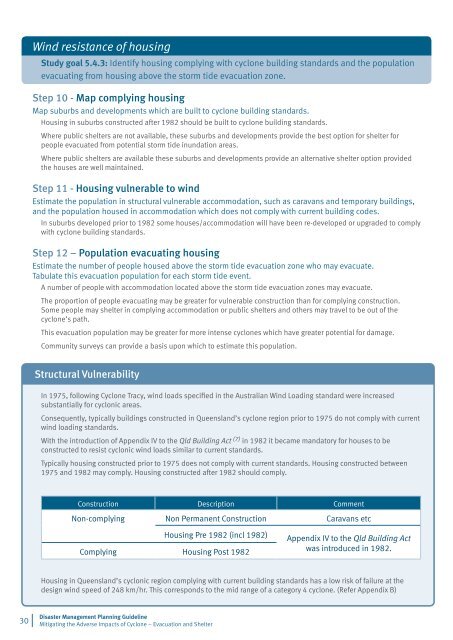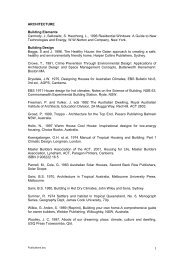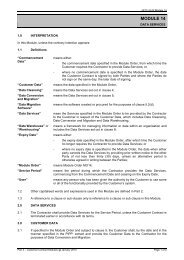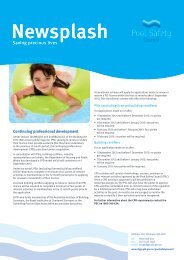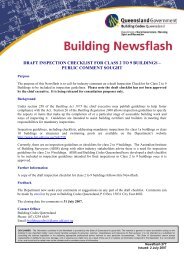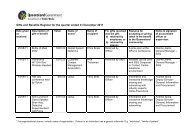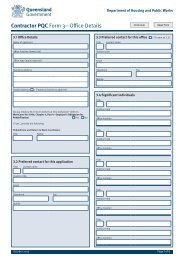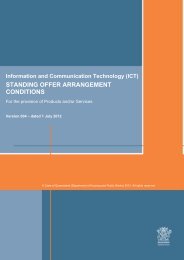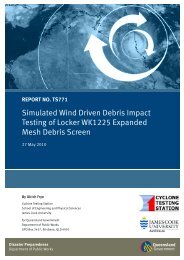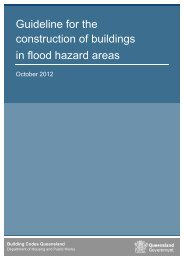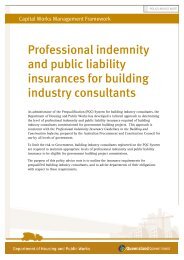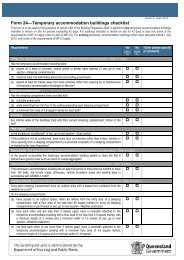Guideline - Department of Housing and Public Works - Queensland ...
Guideline - Department of Housing and Public Works - Queensland ...
Guideline - Department of Housing and Public Works - Queensland ...
You also want an ePaper? Increase the reach of your titles
YUMPU automatically turns print PDFs into web optimized ePapers that Google loves.
Wind resistance <strong>of</strong> housing<br />
Study goal 5.4.3: Identify housing complying with cyclone building st<strong>and</strong>ards <strong>and</strong> the population<br />
evacuating from housing above the storm tide evacuation zone.<br />
Step 10 - Map complying housing<br />
Map suburbs <strong>and</strong> developments which are built to cyclone building st<strong>and</strong>ards.<br />
<strong>Housing</strong> in suburbs constructed after 1982 should be built to cyclone building st<strong>and</strong>ards.<br />
Where public shelters are not available, these suburbs <strong>and</strong> developments provide the best option for shelter for<br />
people evacuated from potential storm tide inundation areas.<br />
Where public shelters are available these suburbs <strong>and</strong> developments provide an alternative shelter option provided<br />
the houses are well maintained.<br />
Step 11 - <strong>Housing</strong> vulnerable to wind<br />
Estimate the population in structural vulnerable accommodation, such as caravans <strong>and</strong> temporary buildings,<br />
<strong>and</strong> the population housed in accommodation which does not comply with current building codes.<br />
In suburbs developed prior to 1982 some houses/accommodation will have been re-developed or upgraded to comply<br />
with cyclone building st<strong>and</strong>ards.<br />
Step 12 – Population evacuating housing<br />
Estimate the number <strong>of</strong> people housed above the storm tide evacuation zone who may evacuate.<br />
Tabulate this evacuation population for each storm tide event.<br />
A number <strong>of</strong> people with accommodation located above the storm tide evacuation zones may evacuate.<br />
The proportion <strong>of</strong> people evacuating may be greater for vulnerable construction than for complying construction.<br />
Some people may shelter in complying accommodation or public shelters <strong>and</strong> others may travel to be out <strong>of</strong> the<br />
cyclone’s path.<br />
This evacuation population may be greater for more intense cyclones which have greater potential for damage.<br />
Community surveys can provide a basis upon which to estimate this population.<br />
Structural Vulnerability<br />
In 1975, following Cyclone Tracy, wind loads specified in the Australian Wind Loading st<strong>and</strong>ard were increased<br />
substantially for cyclonic areas.<br />
Consequently, typically buildings constructed in Queensl<strong>and</strong>’s cyclone region prior to 1975 do not comply with current<br />
wind loading st<strong>and</strong>ards.<br />
With the introduction <strong>of</strong> Appendix IV to the Qld Building Act (7) in 1982 it became m<strong>and</strong>atory for houses to be<br />
constructed to resist cyclonic wind loads similar to current st<strong>and</strong>ards.<br />
Typically housing constructed prior to 1975 does not comply with current st<strong>and</strong>ards. <strong>Housing</strong> constructed between<br />
1975 <strong>and</strong> 1982 may comply. <strong>Housing</strong> constructed after 1982 should comply.<br />
Construction Description Comment<br />
Non-complying Non Permanent Construction Caravans etc<br />
<strong>Housing</strong> Pre 1982 (incl 1982)<br />
Complying <strong>Housing</strong> Post 1982<br />
Appendix IV to the Qld Building Act<br />
was introduced in 1982.<br />
<strong>Housing</strong> in Queensl<strong>and</strong>’s cyclonic region complying with current building st<strong>and</strong>ards has a low risk <strong>of</strong> failure at the<br />
design wind speed <strong>of</strong> 248 km/hr. This corresponds to the mid range <strong>of</strong> a category 4 cyclone. (Refer Appendix B)<br />
30 |<br />
Disaster Management Planning <strong>Guideline</strong><br />
Mitigating the Adverse Impacts <strong>of</strong> Cyclone – Evacuation <strong>and</strong> Shelter


